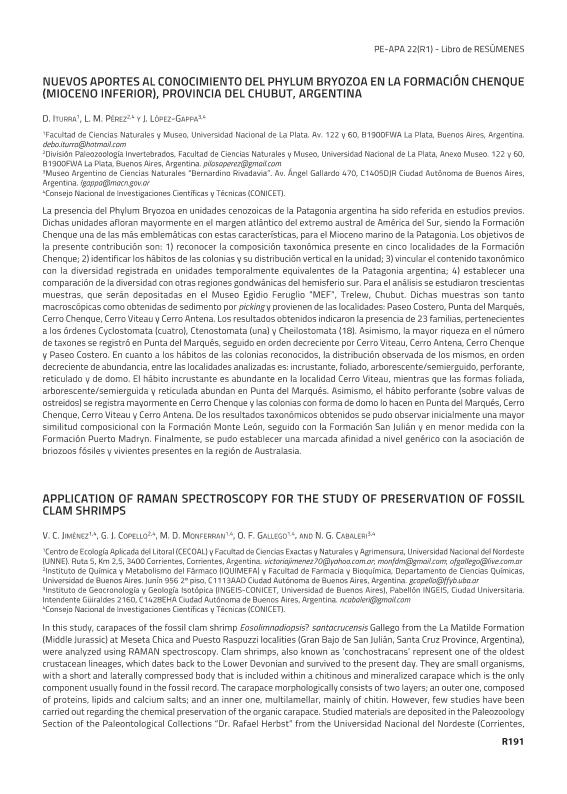Evento
Application of raman spectroscopy for the study of preservation of fossil clam shrimps
Jiménez, Victoria Cecilia ; Copello, Guillermo Javier
; Copello, Guillermo Javier ; Monferran, Mateo Daniel
; Monferran, Mateo Daniel ; Gallego, Oscar Florencio
; Gallego, Oscar Florencio ; Cabaleri, Nora Graciela
; Cabaleri, Nora Graciela
 ; Copello, Guillermo Javier
; Copello, Guillermo Javier ; Monferran, Mateo Daniel
; Monferran, Mateo Daniel ; Gallego, Oscar Florencio
; Gallego, Oscar Florencio ; Cabaleri, Nora Graciela
; Cabaleri, Nora Graciela
Tipo del evento:
Congreso
Nombre del evento:
XII Congreso de la Asociación Paleontológica Argentina
Fecha del evento:
23/11/2021
Institución Organizadora:
Asociación Paleontológica Argentina;
Título de la revista:
Publicación Electrónica Asociación Paleontológica Argentina
Editorial:
Asociación Paleontológica Argentina
ISSN:
2469-0228
Idioma:
Inglés
Clasificación temática:
Resumen
In this study, carapaces of the fossil clam shrimp Eosolimnadiopsis? santacrucensis Gallego from the La Matilde Formation (Middle Jurassic) at Meseta Chica and Puesto Raspuzzi localities (Gran Bajo de San Julián, Santa Cruz province, Argentina), were analyzed using RAMAN spectroscopy. Clam shrimps, also known as 'conchostracans' represent one of the oldest crustacean lineages, which dates back to the Lower Devonian and survived to the present day. They are small organisms, with a short and laterally compressed body that is included within a chitinous and mineralized carapace which is the only component usually found in the fossil record. The carapace morphologically consists of two layers; an outer one, composed of proteins, lipids and calcium salts; and an inner one, multilamellar, mainly of chitin. However, few studies have been carried out regarding the chemical preservation of the organic carapace. Studied materials are deposited in the Paleozoology Section of the Paleontological Collections ?Dr. Rafael Herbst? from the Universidad Nacional del Nordeste (Corrientes, Argentina) under the acronym CTES-PZ. The Raman spectra were obtained by the RAMAN Thermo-Fischer DXR microscope, the parameters used in the analyzes were: 780 nm diode laser, power of 10.0 mW with a slit aperture of 25 μm and exposure time of 70 s. The results of the studied samples from Meseta Chica locality, revealed different percentages of amorphous carbon, more ordered and disordered graphitic that is expressed in the G (~ 1600 cm-1) and D (~ 1360 cm-1) bands. For the G band, a center at 1600 +/- 10 was used and the settings fluctuated between 1600 and 1594 cm-1 and for the deconvolution of the D1 band, a center set at 1350 +/-10 was used and all ranged between 1353-1360 cm-1. A peak was also observed at 461.5 cm-1 which could be due to a phosphate. Moreover, the carapaces from Puesto Raspuzzi locality, also show a band at ~ 1347 cm-1 assigned to band D related to structural defects in carbonaceous materials, and a peak at ~ 1590 cm-1 assigned to band G of carbon was obtained. Therefore, the presence of carbonaceous material was determined in the carapace remains of both localities. This is related to the preservation of an aliphatic hydrocarbon component already observed in other fossil arthropods. The presence of the hydrocarbon in the studied clam shrimp remains is interpreted as the preservation of the degraded internal cuticle of the carapace, the result of an in-situ polymerization process that occurred both in Meseta Chica and Puesto Raspuzzi samples. The presence of carbonaceous remains in the analyzed localities thus suggests a high percentage of preservation of organic remains, mainly derived from carapace remains (chitin), indicating similar modes of preservation. This abstract takes an important step to clarify the modes of preservation of clam shrimp carapaces regarding their organic chemical composition.
Palabras clave:
PRESERVATION OF FOSSIL
,
CLAM SHRIMPS
,
LA MATILDE FOMATION
,
JURASSIC
,
PATAGONIA
Archivos asociados
Licencia
Identificadores
Colecciones
Eventos(CECOAL)
Eventos de CENTRO DE ECOLOGIA APLICADA DEL LITORAL (I)
Eventos de CENTRO DE ECOLOGIA APLICADA DEL LITORAL (I)
Eventos(INGEIS)
Eventos de INST.DE GEOCRONOLOGIA Y GEOLOGIA ISOTOPICA (I)
Eventos de INST.DE GEOCRONOLOGIA Y GEOLOGIA ISOTOPICA (I)
Eventos(IQUIMEFA)
Eventos de INST.QUIMICA Y METABOLISMO DEL FARMACO (I)
Eventos de INST.QUIMICA Y METABOLISMO DEL FARMACO (I)
Citación
Application of raman spectroscopy for the study of preservation of fossil clam shrimps; XII Congreso de la Asociación Paleontológica Argentina; Buenos Aires; Argentina; 2021; 1-2
Compartir



